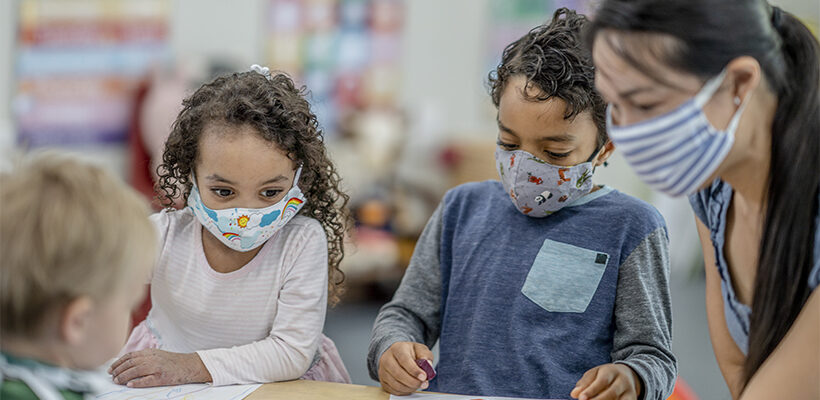
COVID-19 Updates in Childcare
COVID-19 cases and outbreaks continue to pop up in childcare, daycare, and preschool facilities. As a friendly reminder, all COVID-19 cases within Spokane County should be reported to Spokane Regional Health District (SRHD) as soon as possible and all COVID-19 positives and close contacts should be advised to isolate or quarantine at home as appropriate.
While fewer children have been sick with COVID-19 compared to adults, children can also spread the virus to others. Children, staff, and family members with underlying medical conditions are at increased risk for severe illness from COVID-19. Although the number of children who have been hospitalized with COVID-19 is low compared to adults, one-third of hospitalized children with COVID-19 are admitted to the ICU. Additionally, a small number of children might develop a rare, but serious condition associated with COVID-19 called Multisystem Inflammatory Syndrome in Children (MIS-C). Although the risk for death among children is low compared to adults, some children have died from COVID-19.
SRHD recognizes the critical role childcare programs provide to children and the community. These programs support children’s social-emotional, behavioral, and mental health while fostering early learning development. They can also help serve children in need through nutrition programs, special education services, and after-school programs. In addition, these programs support parents with reliable and safe care so they can return to work. The benefits of keeping childcare programs open are weighed against the risks posed by COVID-19 spread in the childcare program and the ability of childcare facilities to mitigate risk.

Changing guidance can create confusion regarding advice to COVID-19 positive cases and close contacts associated with childcare facilities. To clarify, here are the current guidelines:
- COVID-19 positive individuals (those who are symptomatic and/or test positive) should isolate at home for at least 10 days after symptom onset (or test date in the case of asymptomatic individuals). They can return after that period of time provided their symptoms have improved and they have been fever-free for at least 24 hours without fever reducing medication.
- Symptomatic individuals (not including those with loss of taste or smell) with no known exposure to someone with COVID-19 can be exempt from the 10-day isolation period if their initial test result is negative, their symptoms resolve within <24 hours, or they can acquire a doctor’s note diagnosing all of their symptoms as something non-COVID-19 related.
- Close contacts, including kids and staff within the same cohort, should quarantine at home for 14 days (this can be reduced to 10 days if 14 is too burdensome).
- Household contacts, including siblings, should quarantine at home for 24 days. This reflects the need for household contacts to quarantine for 14 days after the last day that they were in close contact with a COVID-19 positive person; usually that 14-day quarantine does not officially begin until after the sick person’s 10-day isolation has ended (10 + 14 = 24).
- This could be reduced to 20 days if 24 days is too burdensome.
- Or it could be reduced to 14 days for household contacts who can completely isolate away from a COVID-19 positive person for the entire period of time that the COVID positive person is contagious (at least 10 days).
- Fully vaccinated individuals and individuals who have previously recovered from a COVID-19 infection within the past 90 days (proven by a positive test result) are exempt from needing to test or quarantine after an exposure, provided they remain symptom free, don’t test positive, monitor for symptoms for 14 days, and continue to adhere to masking and physical distancing guidance.
- Statewide requirements
- Washington State Department of Health, Washington Office of Superintendent of Public Instruction, Washington State Department of Children, Youth & Families Childcare, Youth Development, and Day Camps Guidance
- Washington State Department of Health Secretary of Health Statewide Face Coverings Order 20-03.2
- Washington State Governor’s Office COVID-19 Safe Start – Stay Healthy Proclamation 20-25.6
- SRHD resources
- COVID-19 Information and Resources for Schools
- Letters for School Use (translations available in Arabic, Marshallese, Russian, and Spanish)
- Flowchart for Symptomatic/Not Exposed
- Letter for childcare facilities with updated guidance
- Testing, Quarantine, and Return to Work Guidance
- School COVID-19 Flowchart
- What Am I Sick With?
- COVID-19 Information and Resources for Schools
